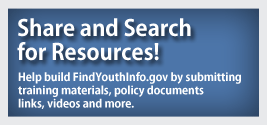Transition to Adulthood
While many youth experience a smooth transition into adulthood and the workforce, some encounter challenges in finding or maintaining employment. LGBT youth may encounter unique challenges in finding jobs and higher education opportunities that are welcoming and supportive. As LGBT youth may experience less supportive school environments than their non-LGBT peers, they may struggle in school and, in turn, have higher school dropout rates than other populations of youth.1 These potentially negative school experiences can affect the postsecondary outcomes of LGBT youth as they transition into employment or postsecondary education.
Colleges and Universities
In looking for postsecondary educational opportunities, it is important that LGBT youth consider the atmosphere and school climate of the college or university they wish to attend. The LGBT-friendly Campus Climate Index is a resource for youth to find higher-education learning environments that are welcoming to LGBT youth. The index has data for 319 campuses. Further, the Consortium of Higher Education LGBT Resource Professionals maintains a directory of colleges and universities that have an office dedicated to LGBT topics.
Employment
LGBT employees experience harassment and discrimination at greater levels than their non-LGBT colleagues.2 One survey found that 44 percent of LGBT adults experienced some form of discrimination on the job because of their sexual orientation.3 There is no federal law that provides workplace protections for LGBT Americans, however, as of June 2012, 16 states and the District of Columbia ban discrimination based on sexual orientation and gender identity/expression, and five additional states ban discrimination based on sexual orientation.4
Employers can protect LGBT employees by developing non-discrimination policies that specifically ban discrimination based on gender identity and sexual orientation for hiring, promotion, termination, and compensation. The U.S. Department of Health and Human Services has implemented a non-discrimination policy statement that includes gender identity and sexual orientation.5 Health and retirement benefits for same-sex partners/spouses, transgender employees, and dependents are also important factors for finding a welcoming job. The U.S. Department of Agriculture (USDA) has created a Lesbian, Gay, Bisexual, and Transgender Special Emphasis Program to discuss and address the unique concerns of LGBT employees in achieving diversity, inclusion, and equal opportunity.6 The Office of Personnel Management, as part of its diversity and inclusion efforts, includes sexual orientation and gender identity in its definition of workforce diversity, which it states is a collection of individual attributes that together help agencies pursue organizational objectives efficiently and effectively. 7 The Office of Personnel Management also notes that federal law prohibits discrimination against applicants to federal positions or federal employees based on sexual orientation.
Employers can benefit from policies and programs, including state laws, which support LGBT employees. Protections for LGBT employees have been found to attract other diverse applicants and fair-minded job seekers.8 For example, a recent survey shows that 71 percent of LGBT adults would prefer a job with an employer in a state where same-sex marriage equality is recognized, and 42 percent would consider changing jobs if their employer moved their position from a state that recognizes same-sex marriage to a state that does not.9 When seeking employment, LGBT youth may likewise consider the policies and practices of an organization, agency, or company before pursuing employment there.
Housing
When transitioning to adulthood some LGBT youth may experience discrimination in housing. The U.S. Department of Housing and Urban Development (HUD) has recently taken steps to provide equal access to housing for LGBT youth and adults, limit discrimination, and provide resources for reporting discrimination.10
Learn more about Transition Age Youth and Youth Employment.
Resources
Housing Discrimination against Lesbian, Gay, Bisexual, and Transgender Individuals and Families
This HUD website maintains a list of states that enumerate sexual orientation and gender identity in their state fair housing laws. It also provides information and resources to report housing discrimination.
LGBT at USDA: The U.S. Department of Agriculture’s Lesbian, Gay, Bisexual, Transgender Special Emphasis Program
This PowerPoint presentation focuses on the USDA’s Lesbian, Gay, Bisexual, and Transgender Special Emphasis Program. It highlights information for a safe, inclusive workplace environment.
Civil Rights at USDA: A Backgrounder on Efforts by the Obama Administration (PDF, 9 pages)
The USDA has a training component that addresses sexual orientation and gender identity diversity and this statement describes the work USDA is doing to improve civil rights.
1 Kosciw et al., 2010; Kim, 2009
2 MAP-Movement Advancement Project, 2011; Badgett, Lau, Sears, & Ho, 2007
3 Out & Equal Workplace Summit, 2009
4 MAP-Movement Advancement Project, 2011; National Gay and Lesbian Task Force, 2012
5 U.S. Department of Health and Human Services, n.d.
6 Stevens, 2011; USDA, 2011; USDA 2010
7 U.S. Office of Personnel Management, 2011
8 Human Rights Campaign, 2008
9 Out & Equal Workplace Summit, 2009
10 Carrol, 2011
Youth Topics
Collaboration Profiles
Youth Voices
Feature Articles
Tools & Guides
Technical Assistance
Websites
Publications
Videos & Podcasts


Announcements
Youth Topics

Map My Community is a tool designed specifically to assist you in locating resources in your community to help you build and strengthen your youth program. Get ideas for new partnerships, identify gaps in your community, and learn about resources to avoid duplication of effort.


















